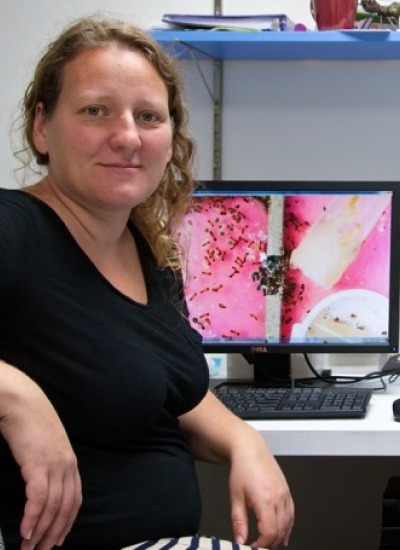Anna R Dornhaus
Publications
Abstract:
Here, we study distribution of workload and its relationship to colony size among worker ants of Temnothorax albipennis, in the context of colony emigrations. We find that one major aspect of workload, number of items transported by each worker, was more evenly distributed in larger colonies. By contrast, in small colonies, a small number of individuals perform most of the work in this task (in one colony, a single ant transported 57% of all items moved in the emigration). Transporters in small colonies carried more items to the new nest per individual and achieved a higher overall efficiency in transport (more items moved per transporter and unit time). Our results suggest that small colonies may be extremely dependent on a few key individuals. In studying colony organisation and division of labour, the amount of work performed by each individual, not just task repertoire (which tasks are performed at all), should be taken into account. © 2008 Springer-Verlag.
PMID: 16049691;Abstract:
When the frenzied and irregular food-recruitment dances of bumblebees were first discovered, it was thought that they might represent an evolutionary prototype to the honeybee waggle dance. It later emerged that the primary function of the bumblebee dance was the distribution of an alerting pheromone. Here, we identify the chemical compounds of the bumblebee recruitment pheromone and their behaviour effects. The presence of two monoterpenes and one sesquiterpene (eucalyptol, ocimene and farnesol) in the nest airspace and in the tergal glands increases strongly during foraging. Of these, eucalyptol has the strongest recruitment effect when a bee nest is experimentally exposed to it. Since honeybees use terpenes for marking food sources rather than recruiting foragers inside the nest, this suggests independent evolutionary roots of food recruitment in these two groups of bees. © Springer-Verlag 2005.
Abstract:
Social insects are distinguished by their extraordinary degree of cooperation and the complexity of their group organization. However, a high proportion of individuals (often >50% at any one time) in a social insect colony tend to be inactive. It has been hypothesized that larger colonies can afford such inactivity because of efficiencies gained through stronger division of labor. We quantify the degree to which colonies of different sizes exhibit division of labor, and what proportion tends to be inactive, in the ant Temnothorax albipennis. Colony size neither influenced individual specialization nor overall division of labor in this species and larger colonies did not show a higher proportion of inactive workers. Interestingly, small colonies seemed to rely more on a small number of high-performance workers: the proportion of work performed by the single most active worker is significantly higher in smaller colonies for several tasks. More research is needed to resolve when and how colony size affects collective organization and division of labor in insect colonies.
PMID: 21888521;Abstract:
Many insects and arthropods live in colonies or aggregations of varying size. Group size may affect collective organization either because the same individual behavior has different consequences when displayed in a larger group or because larger groups are subject to different constraints and selection pressures than smaller groups. In eusocial colonies, group size may have similar effects on colony traits as body size has on organismal traits. Social insects may, therefore, be useful to test theories about general principles of scaling, as they constitute a distinct level of organization. However, there is a surprising lack of data on group sizes in social insects and other group-living arthropods, and multiple confounding factors have to be controlled to detect effects of group size. If such rigorous studies are performed, group size may become as important to understanding collective organization as is body size in explaining behavior and life history of individual organisms. © 2012 by Annual Reviews. All rights reserved.


